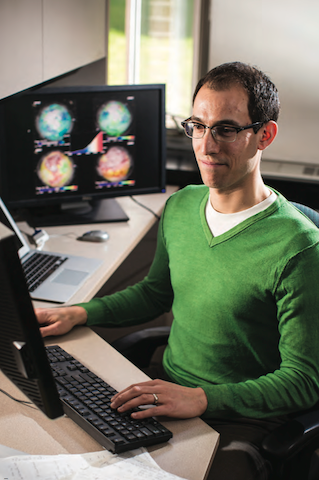
Grant recipient: Chris Fletcher, Department of Geography and Environmental Management
Project team: Chris Fletcher and Chris Raftis*
*Research assistant
(Project timeline: October 2014-September 2015)
Description
A major challenge in science teaching is integrating lecture content with process (experiential) learning in labs. In courses where labs involve computer modelling, a significant barrier to integration can be a student's lack computer programming expertise. This project investigates whether more user-friendly software can help remove this barrier, improve integration between lectures and labs, and promote better knowledge retention. In particular, a series of new labs are created for an undergraduate course on climate modelling using a novel menu-driven application called EdGCM. The original aim was to quantify the effect of the new software on student learning via student test scores and survey responses. While a properly controlled test of EdGCM’s effect on student test scores compared to previous years was not possible, our survey results demonstrate clearly that the software was effective at removing logistical and accessibility barriers that have prevented students from succeeding in the course in previous years.
Intended purpose of teaching enhancement
(i) improved integration of students’ content and process learning; and (ii) increased accessibility to GEOG408 for all students, regardless of their background in computing, by removing logistical and accessibility barriers of existing software.
Findings/Insights
Survey results reveal that students in the class began with moderate-to-good existing knowledge of the climate system (a likely function of the prerequisite), but they still reported much improved confidence in their ability to answer questions on fundamental climate science topics after taking the course. Importantly, 72% of students reported that the EdGCM software had a significant positive impact on their learning of physical climate science. This suggests that we can be reasonably confident that, at least to some extent, the introduction of EdGCM was successful at integrating lectures and labs, and on improving their knowledge retention.
However, the major limitation of the study was that, after beginning the project, we realized that we could find no satisfactory way to conduct a properly controlled test of student test performance relative to previous years. The reason is that the EdGCM software differed so substantially from what was being used previously, that the labs were not able to cover enough of the same material to facilitate a meaningful comparison of grades. Therefore, we are not able to produce a quantitative estimate of the impact of EdGCM on student learning, and we cannot conclude definitively that EdGCM produced better learning outcomes.
Despite this limitation, we still consider the project a success. As stated above, evidence from the pre- and post-class surveys supports the conclusion that EdGCM helps to improve student learning of climate science: students reported that EdGCM had a significant influence on their learning, and other assessment outcomes (for example, the term project) demonstrated equal or greater understanding of the core science concepts compared to previous classes. In addition, it is clear that EdGCM is highly effective at removing logistical and accessibility barriers associated with the previous software and labs. This has two major benefits, because it allows: (i) students from a wider range of academic backgrounds to take the course, and (ii) for a larger class size because the EdGCM software requires the instructor to spend less time assisting individual students with programming-related issues.
Dissemination and Impact
- At the individual level: I have discussed this project informally with colleagues from Faculty of Environment, and from across campus (e.g. in Applied Math). More formally, the licenses purchased in support of the project (funded by the department of Geography) are now available for use by other instructors in the Faculty of Environment, and the documentation/user manuals created during the project will be made freely available.
- At the Department/School and/or Faculty/Unit levels: After discussions with the instructor, there is a possibility that this software will be adopted in another course: GEOG309 Physical Climatology. If additional software licenses are required, we will put together a joint funding justification to the Dean of Environment. Lastly, I will be making a presentation on this project at the ENV GreenTEA seminar series some time in 2016.
- At the national and/or international levels: I have submitted an abstract on this project at the American Geophysical Union Fall Meeting in San Francisco in December 2015, entitled “Does Introducing more User-friendly Software Produce better Integrated Learning in an Undergraduate Course on Climate Modelling?”. This presents a great opportunity to disseminate information about the study, and also to foster new networks and collaborations on this or related topics.
Impact of the Project
- Teaching: The scope and breadth of lab assignments, and the term project, in GEOG408 are changed immensely as a result of this project. The possibilities for experiential learning are so much larger with the new software that the main challenge now is to provide suitable boundaries for what the students should do in assignments. In addition, in my other teaching (an introductory climate course, and a course on research methods), I plan to introduce examples that use EdGCM, and recommend that students begin experimenting with the software (for example in term projects).
- Connections with people from different departments, faculties, and/or disciplines about teaching and learning: As a result of this project I have contacted an educational researcher at McGill University, who is investigating the impact of EdGCM on learning of climate science at a cégep in Montreal. We plan to collaborate on this topic in future, possibly on a publication to an educational research journal. I also shared ideas with a researcher from Iowa State who has used EdGCM in his climate science course for several years. In addition, I will connect with many other educational research colleagues at the AGU meeting in San Francisco in December 2015.
References
Project reference list (PDF)